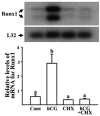Luteinizing hormone-induced RUNX1 regulates the expression of genes in granulosa cells of rat periovulatory follicles
- PMID: 16675540
- PMCID: PMC1783681
- DOI: 10.1210/me.2005-0512
Luteinizing hormone-induced RUNX1 regulates the expression of genes in granulosa cells of rat periovulatory follicles
Abstract
The LH surge induces specific transcription factors that regulate the expression of a myriad of genes in periovulatory follicles to bring about ovulation and luteinization. The present study determined 1) the localization of RUNX1, a nuclear transcription factor, 2) regulation of Runx1 mRNA expression, and 3) its potential function in rat ovaries. Up-regulation of mRNA and protein for RUNX1 is detected in preovulatory follicles after human chorionic gonadotropin (hCG) injection in gonadotropin-treated immature rats as well as after the LH surge in cycling animals by in situ hybridization and immunohistochemical and Western blot analyses. The regulation of Runx1 mRNA expression was investigated in vitro using granulosa cells from rat preovulatory ovaries. Treatments with hCG, forskolin, or phorbol 12 myristate 13-acetate stimulated Runx1 mRNA expression. The effects of hCG were reduced by inhibitors of protein kinase A, MAPK kinase, or p38 kinase, indicating that Runx1 expression is regulated by the LH-initiated activation of these signaling mediators. In addition, hCG-induced Runx1 mRNA expression was inhibited by a progesterone receptor antagonist and an epidermal growth factor receptor tyrosine kinase inhibitor, whereas amphiregulin stimulated Runx1 mRNA expression, demonstrating that the expression is mediated by the activation of the progesterone receptor and epidermal growth factor receptor. Finally, knockdown of Runx1 mRNA by small interfering RNA decreased progesterone secretion and reduced levels of mRNA for Cyp11a1, Hapln1, Mt1a, and Rgc32. The hormonally regulated expression of Runx1 in periovulatory follicles, its involvement in progesterone production, and regulation of preovulatory gene expression suggest important roles of RUNX1 in the periovulatory process.
Figures









Similar articles
-
Progesterone receptor activation mediates LH-induced type-I pituitary adenylate cyclase activating polypeptide receptor (PAC(1)) gene expression in rat granulosa cells.Biochem Biophys Res Commun. 2000 Oct 14;277(1):270-9. doi: 10.1006/bbrc.2000.3667. Biochem Biophys Res Commun. 2000. PMID: 11027674
-
Response gene to complement 32 expression is induced by the luteinizing hormone (LH) surge and regulated by LH-induced mediators in the rodent ovary.Endocrinology. 2008 Jun;149(6):3025-36. doi: 10.1210/en.2007-1129. Epub 2008 Feb 28. Endocrinology. 2008. PMID: 18308847 Free PMC article.
-
Cyclic guanosine 5'-monophosphate-dependent protein kinase II is induced by luteinizing hormone and progesterone receptor-dependent mechanisms in granulosa cells and cumulus oocyte complexes of ovulating follicles.Mol Endocrinol. 2006 Feb;20(2):348-61. doi: 10.1210/me.2005-0317. Epub 2005 Oct 6. Mol Endocrinol. 2006. PMID: 16210344
-
Estrogen receptor-beta mRNA expression in rat ovary: down-regulation by gonadotropins.Mol Endocrinol. 1997 Feb;11(2):172-82. doi: 10.1210/mend.11.2.9887. Mol Endocrinol. 1997. PMID: 9013764
-
Signal pathway of LH-induced expression of nuclear progestin receptor in vertebrate ovulation.Gen Comp Endocrinol. 2022 Jun 1;321-322:114025. doi: 10.1016/j.ygcen.2022.114025. Epub 2022 Mar 12. Gen Comp Endocrinol. 2022. PMID: 35292264 Review.
Cited by
-
Large-scale DNA demethylation occurs in proliferating ovarian granulosa cells during mouse follicular development.Commun Biol. 2021 Nov 25;4(1):1334. doi: 10.1038/s42003-021-02849-w. Commun Biol. 2021. PMID: 34824385 Free PMC article.
-
Prostate androgen-regulated mucin-like protein 1: a novel regulator of progesterone metabolism.Mol Endocrinol. 2013 Nov;27(11):1871-86. doi: 10.1210/me.2013-1097. Epub 2013 Oct 1. Mol Endocrinol. 2013. PMID: 24085821 Free PMC article.
-
Activation of Steroidogenesis, Anti-Apoptotic Activity, and Proliferation in Porcine Granulosa Cells by RUNX1 Is Negatively Regulated by H3K27me3 Transcriptional Repression.Genes (Basel). 2020 Apr 30;11(5):495. doi: 10.3390/genes11050495. Genes (Basel). 2020. PMID: 32365901 Free PMC article.
-
Transcriptomic signatures for ovulation in vertebrates.Gen Comp Endocrinol. 2017 Jun 1;247:74-86. doi: 10.1016/j.ygcen.2017.01.019. Epub 2017 Jan 19. Gen Comp Endocrinol. 2017. PMID: 28111234 Free PMC article.
-
Androgen-induced epigenetic modulations in the ovary.J Endocrinol. 2021 Jun;249(3):R53-R64. doi: 10.1530/JOE-20-0578. J Endocrinol. 2021. PMID: 33764313 Free PMC article. Review.
References
-
- Espey LL, Richards JS. Temporal and spatial patterns of ovarian gene transcription following an ovulatory dose of gonadotropin in the rat. Biol Reprod. 2002;67:1662–1670. - PubMed
-
- Richards JS, Russell DL, Ochsner S, Espey LL. Ovulation: new dimensions and new regulators of the inflammatory-like response. Annu Rev Physiol. 2002;64:69–92. - PubMed
-
- Richards JS. Ovulation: new factors that prepare the oocyte for fertilization. Mol Cell Endocrinol. 2005;234:75–79. - PubMed
Publication types
MeSH terms
Substances
Grants and funding
LinkOut - more resources
Full Text Sources
Other Literature Sources
Molecular Biology Databases
Research Materials

